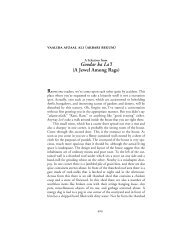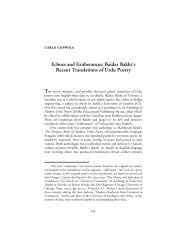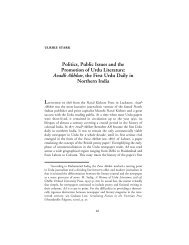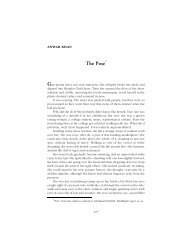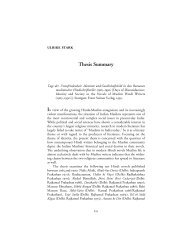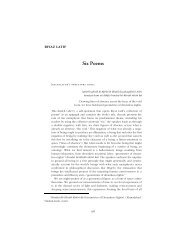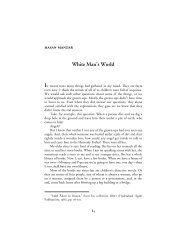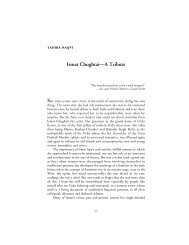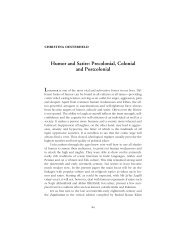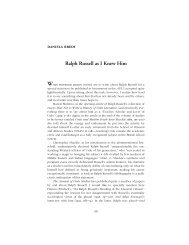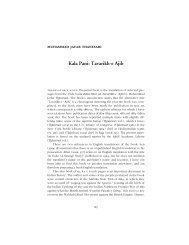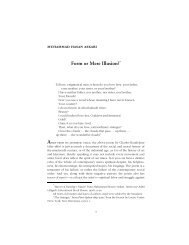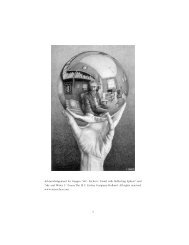Delhi College and Urdu* - MINDS@UW Home
Delhi College and Urdu* - MINDS@UW Home
Delhi College and Urdu* - MINDS@UW Home
Create successful ePaper yourself
Turn your PDF publications into a flip-book with our unique Google optimized e-Paper software.
GAIL MINAULT • 121on printed textbooks that could be mechanically reproduced <strong>and</strong> hencereadily <strong>and</strong> cheaply available for students to read. Orality was being replacedby print, consequently, <strong>and</strong> thus the teacher-student relationship,while still important, was challenged by the vision of the individualscholar, deriving his knowledge from books or scientific observations.Such an individual style of scholarship necessitated the exchange of ideasvia print, in scholarly journals or more popular periodicals. 8Similar to <strong>Delhi</strong> <strong>College</strong>, Urdu was a mediator. For the later Mughalemperors, Urdu had already become a mediating language betweenPersian <strong>and</strong> regional Indian languages, <strong>and</strong> between the imperial court<strong>and</strong> various regional powers. For the British too, Urdu (or Hindustani)filled the need for an Indian vernacular that was more generally understoodthan Persian, but that nevertheless had an association with government<strong>and</strong> incorporated administrative terms <strong>and</strong> concepts. It is importantto remember that, as part of the process that resulted in the establishmentof English as the language of higher administration in India in the nineteenthcentury, the vernaculars also achieved new recognition, utility, <strong>and</strong>importance. At <strong>Delhi</strong> <strong>College</strong>, Urdu was the common language in whichthe dialogue between different curricula, styles of teaching, <strong>and</strong> modes oftransmission of knowledge was carried out. 9The Foundations of <strong>Delhi</strong> <strong>College</strong>The British government in India first began to take responsibility for theeducation of Indian élites following the revision of the East IndiaCompany’s charter in 1813, when a sum was set aside from a projectedsurplus in the annual revenues for the support of education. The particu-8 See, e.g., Dale Eickleman, “The Art of Memory: Islamic Education <strong>and</strong> itsSocial Reproduction,” Comparative Studies in Society <strong>and</strong> History [CSSH], 20:4(Oct. 1978), 485–516; various articles in N. Gr<strong>and</strong>in <strong>and</strong> M. Gaborieau, eds.,Madrasa: La Transmission du Savoir dans le Monde Musulman (Paris: Edns.Arguments, 1997); <strong>and</strong> Francis Robinson, “Technology <strong>and</strong> Religious Change:Islam <strong>and</strong> the Impact of Print,” Modern Asian Studies [MAS], 27:1 (1993), 229–51.9 Muzaffar Alam, “The Pursuit of Persian: Languages in Mughal Politics,”MAS, 32:2 (1998), 317–49; David Lelyveld, “Zub≥n-e Urd∑-e Mu‘all≥ <strong>and</strong> the Idolof Linguistic Origins,” Annual of Urdu Studies [AUS], 9 (1994), 107–17; cf.Sheldon Pollock, “The Cosmopolitan Vernacular,” Journal of Asian Studies [JAS],57:1 (1998), 6–37.



